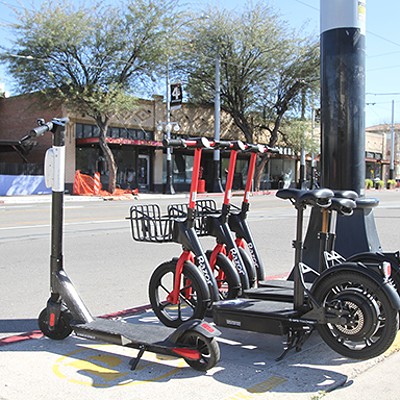But how is it doing as a real estate venture?
After purchasing the depot six years ago for $2.1 million and deciding to restore the main building to its 1941 appearance, city officials spoke of making it a "multi-modal transportation center as a part of a long-term revitalization of the downtown area." To accomplish that goal, various forms of transit were to be located at the station (see "Leave the Driving to Us," Jan. 22). In addition, the mostly vacant structures were to become a hub of restaurants, offices and commercial activity on the east end of downtown.
But with the two-year rehabilitation effort almost finished, the only guaranteed tenants are Amtrak and the Southern Arizona Transportation Museum. The ticketing operation and waiting room for the national rail passenger service are moving back into the depot after having been relocated to allow for construction work, while the museum is expected to open by next January in one of the three outbuildings on the property.
Most of the main structure and two of the outbuildings remain vacant--but it doesn't deter enthusiasm for the project. Local commercial real estate businessman Buzz Isaacson has been handling depot negotiations for the city and believes the current downtown revitalization emphasis makes this effort appropriate.
"Downtown is heading in the right direction and is ready for this project," he says. "There is a high level of interest (in the depot) at this point. Now is the right time for it, unlike over much of the last 20 years."
Isaacson hopes the first small office tenant will sign a lease shortly and move in by May. A restaurant, which will occupy about 3,000 square feet of space, could follow by August. Indicating the intention is to have a "unique" dining establishment, something like Cafe Poca Cosa, Isaacson adds that no national chains were asked to locate in the building.
John Updike, from the city's Rio Nuevo office, says he wants to see a healthy tenant go into the space. "We want someone with a good business plan, not somebody who will open and close within six months. We want a long-term, lasting relationship," he says.
While the restaurant will be located on the ground level, there is also 7,000 square feet available on the second floor of the depot. Once the home of Southern Pacific Railroad Company's administration department, it offers spectacular views of the Santa Catalina Mountains. Updike says the city is negotiating with two potential lessees for this space, either of which could take about three-quarters of it for offices.
Finding office or retail tenants for the two vacant outbuildings may take longer, Updike believes. They don't have the pizazz of the main structure, but he indicates that "a couple of folks seem to be interested."
While emphasizing that he is "thrilled" and "looking forward to having new neighbors," Richard Oseran--owner of Hotel Congress, located across the street from the depot--has some concerns. Oseran believes that almost 160 parking spaces will be lost due to various planned construction projects, and he fears that this lack of parking will impact his business and make renting space in the depot more difficult.
In the short-term, Oseran would like to see new, diagonal parking along Toole Avenue. In the long run, he thinks 500 spaces are needed nearby and hopes the city will build a new garage where the Greyhound Bus station is now located.
Oseran's other worry concerns the number of construction projects planned for the immediate vicinity, including a new Fourth Avenue underpass, the reconfiguration of Broadway Boulevard (and possibly Congress Street), new apartment housing, outdoor amenities and, potentially, the relocated Greyhound terminal.
Oseran forecasts "severe restrictions of access everywhere" if these projects are implemented. "That will certainly have an impact," he adds.
Both Isaacson and Updike agree that parking and future construction may affect depot tenants, and they say that they've discussed these issues with potential renters. But even with that, Isaacson adds, "No one has said the depot project was a bad idea, that it won't work."
The late Arthur Keating envisioned the potential benefits of the depot project more than a dozen years ago, and developed a "Depot Gateway Vision" plan that pushed for the dilapidated train station's restoration. Keating had very specific ideas for the property and alienated a lot of people with his stubbornness, but his role in the depot's successful revitalization should not be forgotten, according to Updike.
"His passion carried the day," Updike says. "It was a kick in the pants to us to get our own act together."












